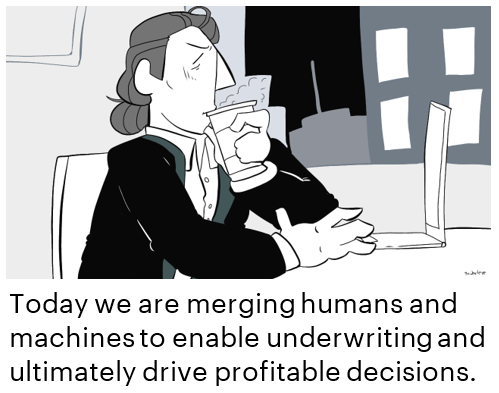Other parts of this series:
In the first two parts of this series on the future of underwriting, we looked at how data, omnichannel access, and intelligent tools can be used to gather, validate, supplement and prepare information for underwriters. In this post, we’ll shift our focus to underwriting itself and how collaboration between humans and intelligent tools can take it to new heights.
Is tomorrow’s underwriter a human or a robot?
The specter of humans losing their jobs to robots looms over any discussion of applying intelligent tech. But the choice carriers face right now isn’t a binary decision of whether the human or the machine should underwrite the risk. Rather, it is a question of how best to leverage machines to help human underwriters more consistently make profitable underwriting decisions.

This is not to deny the existence of automated underwriting—it’s already here, and it’s going to keep expanding to cover homogenous risks. However, human intervention will continue to be required for more complex cases and coverages. The future of high-end underwriting lies in figuring out how to best blend the intuition and expertise of humans with the processing capabilities of machines.
Machines supercharge expertise
One of the most valuable skills of an expert underwriter is their ability to assess risk against a peer group of similar risks from the underwriter’s experience to help determine the relative risk of a policyholder. Pairing a human underwriter with intelligent tech improves this process by using comparative analytics to measure an individual account against peer companies in the carrier’s portfolio to create a more comprehensive view of the risk in the account.
Smart machines mean that an underwriter doesn’t need to rely solely on their own experience and judgment when examining the details of a submission. When the underwriter is examining a submission’s details like payroll, assets, finances, losses, population, or driving record, they don’t just have to rely on their own expertise. Instead, an analytical dashboard can highlight where this specific account is better or worse than its peer group. This information helps the underwriter determine the overall risk of the account and how aggressively they should price it. More importantly, it helps prevent them from believing an account is better or worse than it actually is by providing an empirical view to assist the consistency of their judgment.
Eliminating blind spots and boosting productivity
Machines can also enable the underwriter to be more productive and process large numbers of assets without missing any important details.
For example, on large property and auto accounts, it’s not unusual for an underwriter to need to assess hundreds of properties or vehicles. Analytics and machine learning techniques can be applied to identify properties or vehicles that require special attention because of defined hazards or outlying information. With these tools, an underwriter can quickly identify elements from the long list that needs human attention. This makes the underwriter much less likely to miss exposures. For employee-benefit underwriters, similar techniques can be applied to help assess large schedules of benefits and classes.
A new era of underwriting
Improvements like these represent a new chapter in the history of underwriting. The original focus of underwriting was on capturing the information needed for the policy or quote in our rating and quoting systems. Then we had the push to build out workflows to help us manage and move work along the underwriting process. Today, we need to enable the underwriter with overlay intelligently prepared data and insights in the workflow to empower them to make more consistent high-quality decisions leading to better underwriting results.










